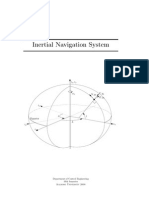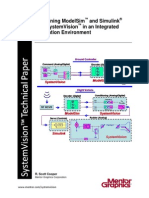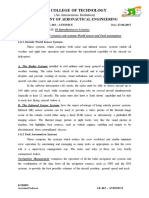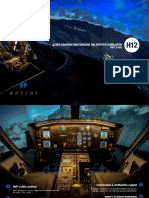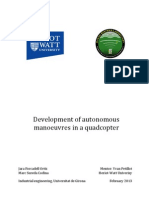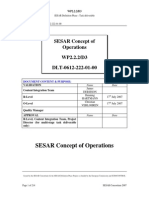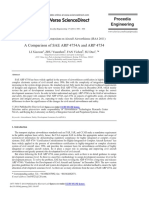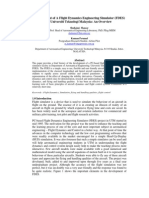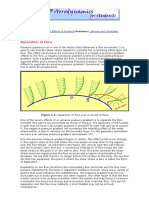At a glance
Powered by AI
This document discusses the development of a flight simulation system for educational purposes at Chulalongkorn University in Thailand.
International School of
Engineering
Chulalongkorn
University
F
LIGHT SIMULATION
Raksok Khankhampoch
ID: 503 13960 21
E-mail: k.raksok@live.com Phone: 085 393 5599
Sorasit Thongjeen ID:
503 14359 21
E-mail: sorasit_wasup@hotmail.com Phone: 080 595 7849
Advisor: Asst. Prof. Niphon Wansophark
Signature Date
.
Academic Year 2010
Page
1
| AERO Senior Project Final Report 2010 Flight Simulation
1. Introduction
In the past, because of complexity of the calculation process inside the system, flight simulation is limited only for a group of expert scientist or engineers whose can afford a mainframe computer or a super computer to handle such a level of calculation, and another reason for it to be confine only within a group of expert is that each mainframe required specific input code to be programed to handle the process. So, the development is confine only in major institute. However, since the starting of the silicon age, consumer level computers are becoming smaller whereas having higher calculation power. Also from the development of software in both quality and compatibility to have better method of presenting and operating (i.e. no specific code need to be program for each kind of machine). With these two major reason, a possibility of the building flight simulation on consumer level computer arise and has been continuing develop widely around the world for many application (e.g. flight control development, flight test support). This project was motivated from those reasons, and for the benefit of Aerospace engineering students at ISE, Faculty of engineering, Chulalongkorn University that can use this system in aircraft design process. The flight simulations that use in aircraft design process are difference from those that use for crew training or entertainment purpose (gaming) which is a level of data acquisition. For a design process, it is almost 2 times higher level of data acquisition than that for training. The flight simulation system is a large scale project compose with significant level of complexity with the limitation of time, this project will concentrate on the control system of the aircraft. Therefore, the expected out comes at the end of the project is to use this flight simulation system to observe the handling quality of the aircraft.
2. Background
2.1 Flight dynamics
The main component for flight dynamics are
2.1.1. Equation of motion
The equations of motion are focal point of all flight simulators. They determine the state of the simulator, taking all the inputs, including pilot controls, winds, aerodynamic terms and engine terms to compute the variables that represent the state of the simulated aircraft, particularly forces, moments, attitude, altitude, heading and velocities. This translation of inputs to outputs depends on the equations of motions used to resolve the linear and rotary motion of the aircraft and includes the aerodynamic data for the aircraft, details of the undercarriage and engine data, usually provided in the form of tables and graphs of data.
2.1.2. Aircraft model
The aerodynamic model enables the aerodynamic forces and moments to be computed. For example, the coefficient of lift may be derived as a function of the angle of attack where the specific aerodynamic coefficients are defined in the aerodynamic database. The aerodynamic data is provided as a large database, typically in the form of several thousand graphs of the aerodynamic variables, often as functions of two or three variables. This database is likely to have been obtained from a combination of flight testing, wind tunnel tests and possibly computational fluid dynamics (CFD) analysis. The database will also include a vast amount of
Flight Simulation AERO Senior Project Final Report 2010 | Page
2
validation data to enable the simulator developer to compare the simulator dynamics and
performance with actual aircraft data. From the manufacturer‟s perspective, this data has high
commercial value and is usually provided as part of a confidential agreement between the operator, the aircraft manufacturer and the simulator manufacturer. The aerodynamics model is possibly the most critical element of a flight simulator/simulation. An error in modeling the aircraft aerodynamics can lead to a simulation which might fail. Consequently, the aerodynamic data package produced by the aircraft manufacturer is expensive. For this reason, there are very few detailed data packages available in the public domain. Although it is possible to acquire this data from flight trials, the cost of aircraft instrumentation, operation of flight trials, data recording and data analysis can be prohibitive to simulator companies. This is an issue sometimes missed by prospective simulator developers; there is no simple way to acquire this data and just a few errors in the aerodynamic data package can result in an unacceptable aircraft model. For this reason, in this project the aerodynamics data are compute from the computer program which gives an acceptable set of data.
2.1.3. Aircraft stability and control
The airplane is a dynamic system with six degrees of freedom, three in translation and three in rotation. In general, airplane motion is characterized by three linear and three angular accelerations under the action of gravitational, Inertial, and aerodynamic and propulsive forces and moments. However, a significant portion of the airplane's flight envelope consists of steady flight conditions such as cruise, climb, or glide. For such flight conditions, the principles of static equilibrium can be applied. This approach can be extended to some class of maneuvers like pull-up from a dive in vertical plane or a steady turn in horizontal plane. This background will also be helpful to understand the dynamic motion of the airplane.
2.2 Computer simulation
Apart from the flight dynamic, the computer simulation is the parts where all the simulation process performs. These important components are:
2.2.1. Data acquisition
In a flight simulation system the flight deck is an exact replica of the aircraft flight deck. Indeed, some of the equipment in the simulator may use actual aircraft parts, as it may be more expensive to fabricate a facsimile than to purchase the certified aircraft equipment. In addition to the primary flight controls (control column, rudder pedals, brakes, flap selector, gear selector, etc.), every lever, selector, knob and switch must be interfaced to the appropriate simulator module. Some of these inputs provide digital data (0 or 1), often referred to as discrete data, whereas other inputs are analogue data. The current selection of inputs must be sampled during each frame, converted to an appropriate value and passed to the relevant simulator module. For some sub-systems, for example, a radio panel, these inputs are monitored and computed by a local processor in the module and passed as serial data or parallel data. Nevertheless, a full flight simulator may have several hundred inputs. Typically, the sampling and storage of this data is handled by one (or more) processor(s), dedicated to the data acquisition function. For analogue data, particularly for the flight controls, data capture is critical to the fidelity of the simulator. The data acquisition software is responsible for minimizing any delay in capturing the data, for ensuring that the resolution of the data is as high as possible and that any signal conditioning or filtering of the data is correctly applied. In practice, data is derived from simulator signals by analogue-to-digital conversion hardware. Although sampling at rates up to 60 Hz is










